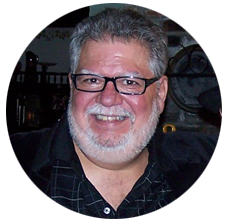By Zeina Abu-Hijleh, Bulletin Staff and
Alison Berstein, Bulletin Correspondent

‘Just because we can read everything online doesn’t mean we enjoy it. for a lot of people, a newspaper feels like a newspaper. online, there is something that is lost. it’s a different reading experience.’
—Jeff Potter, Editor and director of operations,
The Commons, Brattleboro, Vt.
In today’s digital age, many businesses have established a strong online presence.
Newspapers are no exception. One of the ways that many newspapers do so is to offer an online e-edition – a PDF replica of the printed paper – for their readers.
While each medium has its own charms, the traditional printed paper is still running strong, according to New England news industry professionals.
Geographic dependence on printed news
For Randolph T. Holhut, news editor of The Commons of Brattleboro, Vt., geography plays a strong role in the printed newspaper’s dominance over the e-edition.
Internet connections are less available in Vermont than in other areas of New England and so most people rely on printed newspapers, Holhut said.
“Broadband penetration is terribly spotty, especially mobile editions,” he said. “Cell phone services, too. Dead zones are everywhere.”
Although he foresees a more stable online presence in the future, Holhut thinks that a shift to digital would not be an immediate benefit for The Commons.
“It’s really not a high priority for us right now. We know it’s going to be eventually,” he said. “Sooner or later, there is going to be better connectivity to use mobile devices reliably.”
“Right now, if we went only to online news delivery, we would write out 80 percent of readers, maybe more,” he said. “The website is pretty static.”
The Commons is a free newspaper, drawing revenue from donations. Its e-edition is available for free for anyone to download.
To Holhut, making information accessible to all members of the community in that way is crucial.
“As a nonprofit newspaper, it’s a key part of our mission to not have a toll booth in front of information, that it’s available to everyone, regardless of means and technical prowess,” Holhut said. “We have a lot of people that don’t have computers by choice, and people who can’t afford them. Or if they use the internet, they go to their library.”
He wants readers to get their news by the means most convenient for them.
“The paper is (for) a big segment of our community that by choice or circumstance can’t access the paper online,” he said.
Jeff Potter, editor and director of operations of The Commons, finds comfort in the familiarity of a printed newspaper.
“Just because we can read everything online doesn’t mean we enjoy it,” he said. “For a lot of people, a newspaper feels like a newspaper. Online, there is something that is lost. It’s a different reading experience.”
Paid content subsidizes quality journalism
While an e-edition has potential, it struggles to measure up to its printed counterpart, according to Devin Hamilton, publisher of The Journal Tribune of Biddeford, Maine.
“We have a mix. For us, we don’t overly push the digital,” said Hamilton, also a regional publisher of The Eagle Times of Claremont, N.H. “Coming into 2017, we’ll get more like that.”
“If we want professional journalism to continue into the next year and beyond, we have to find a balance of print and digital,” he said.
The Journal Tribune has 4,500 paid daily subscribers to its e-edition, Hamilton said. Paid print subscribers are automatically given a digital subscription.
A subscription is needed to view the e-edition of the Journal Tribune on its website. The price of the subscription varies depending on the content and duration of the subscription. Online-only access ranges from a day to a year – priced at $2.50 and $89, respectively. A one-year subscription for home delivery of the printed paper costs $144.
Without an e-edition subscription, readers can view sample stories at no cost on the website.
“If someone doesn’t subscribe to print but wants online stories, we put one news story and one sports story (online) every day,” Hamilton said. “We make those available, along with columns, other news, community calendar events, and obituaries. Obits for us is 31 percent of online traffic.”
Hamilton said the Journal Tribune is working to amend its subscription policy.
“Instead of spending a certain amount per month, someone would spend per story (for) what they’re interested in,” he said.
Although Hamilton thinks that it is important to grant free access to sample online content, he said that having a substantial amount of content available only on a paid basis helps to subsidize quality journalism.
Readers without subscriptions can view 10 stories a month on the website, a figure that the Journal Tribune is considering halving.
Adhere to generational preferences
Gabriel Martinez, former director of new media at The Daily Item of Lynn, Mass., notes that although 40 percent of its readers subscribe to the e-edition, most readers don’t actually read it.
Readers subscribe to the e-edition through the Daily Item’s website. They select a subscription period for the e-edition – varying from a day to a year. They can also choose whether they want the subscription to renew automatically after each period or to be a single subscription.
“Most readers probably just go online, not really on the e-edition, but just on the website,” Martinez said. “A big trend right now is to have the mobile site replicate what the desktop website looks like and also replicate the feel of what the real paper looks like.”
Most of its readers consume the Daily Item in its printed form and are paid subscribers. Twenty-seven percent of the Daily Item’s subscribers are more than 65 years old.
Different generations have different preferences for consuming media, Martinez noted. He thinks that a newspaper should adhere to those preferences.
“With an older demographic, they’re still used to reading the paper in person and holding it in their hands, whereas millennials such as myself like to go on their phones and social media,” he said.
Preference for the printed newspaper
The Caledonian-Record of St. Johnsbury, Vt., established its e-edition in 2008 and then put up a paywall in 2010 so that only subscribers paying for the service can read it.
“A paper newspaper is still the traditional newspaper; people still want to hold it in their hands,” said Bob DiMatties, circulation director of the Caledonian-Record. “Up here, some people still have dial-up (internet service), so they’re not going to be checking the newspaper online.”
He said another reason the print edition is more popular is that, with a tablet or other electronic device, readers need to fiddle around with a screen to find a suitable text size. A physical newspaper eliminates that tedious process.
Executives interviewed at the Amherst (N.H.) Citizen, the Bristol (Conn.) Press, The Herald News of Fall River, Mass., and the New Haven (Conn.) Independent also said their e-editions are not as popular as their print editions.

‘Most readers probably just go online, not really on the e-edition, but just on the website. A big trend right now is to have the mobile website replicate what the desktop website looks like and also replicate the feel of what the real paper looks like.’
–Gabriel Martinez, Former director of new media
Daily Item, Lynn Mass.

‘A paper newspaper is still the traditional newspaper; people still want to hold it in their hands.’
–Bob DiMatties, Circulation Director
Caledonian-Record, St. Johnsbury, Vt.

‘The (printed) paper is for a big segment of our community that by choice or circumstance can’t access the paper online.’
–Randolph T. Holhut, News editor
The Commons, Brattleboro, Vt.

‘We have a mix. For us, we don’t overly push the digital. Coming into 2017, we’ll get more like that. If we want professional journalism to continue into the next year and beyond, we have to find a balance of print and digital.’
–Devin Hamilton, Publisher
Journal Tribune, Biddeford, Maine
